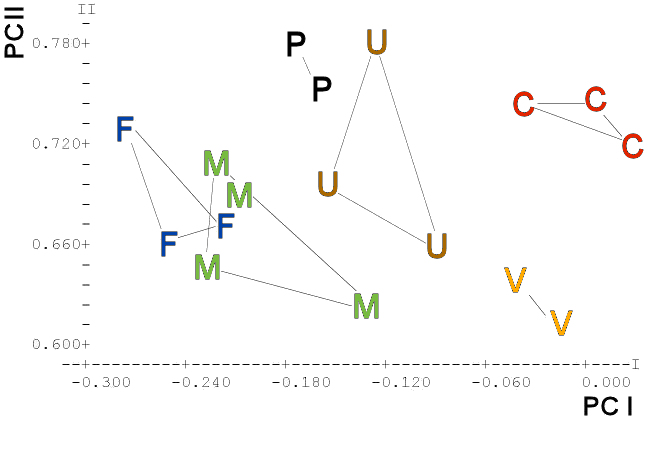
Principal Components Analysis (PCA) of shape variation in Carnivore Skulls
Principal Components Analysis (PCA) is a method
of reducing patterns of variation in multiple separate
dimensions (measurements) of a set of objects into a much
smaller set (often ~3) of combined dimensions that represent a
considerable portion of the variation in the complete set. In
essence, the multi-dimensional shape is rotated mathematically
so as to identify a combination of dimensions that define the
greatest contrast among the objects. This is called the First
Principal Component (PC I): the second and third
axes fall at right angles to the first and represent the next
greatest combinations, and so on. The first three axes may
summarize >50% of the shape variation, and the dimensions
that contribute most to these can often be identified as
coordinated patterns.
In the example, skull morphology of 17 species of Carnivora in six taxonomic families have been summarized by seven measurements, three defining the width, depth, and length of the cranium, three the width, depth, and length of the rostrum (snout), and one for overall skull length. The first six measurement are normalized by the overall skull length, to remove the effect of size differences among larger and smaller skulls. The first PCA axis (PC1) contrasts short-faced felid cats (F) versus long-snout canid dogs (C), with mustelid weasels and relatives (M) being more similar to felids and Old World viverrids (mongooses, V) being more similar to canids. This is in contrast to the phylogenetic relationships, in which Felidae and Viverridae are in one taxonomic suborder, and the other families in another. Procyonid raccoons (P) and ursid bears (U) are intermediate. The second axis (PCII) contrasts flattened skulls in procyonids, canids, and some bears and cats, versus rounder skulls in viverrids and some bears and weasels.
In the example, skull morphology of 17 species of Carnivora in six taxonomic families have been summarized by seven measurements, three defining the width, depth, and length of the cranium, three the width, depth, and length of the rostrum (snout), and one for overall skull length. The first six measurement are normalized by the overall skull length, to remove the effect of size differences among larger and smaller skulls. The first PCA axis (PC1) contrasts short-faced felid cats (F) versus long-snout canid dogs (C), with mustelid weasels and relatives (M) being more similar to felids and Old World viverrids (mongooses, V) being more similar to canids. This is in contrast to the phylogenetic relationships, in which Felidae and Viverridae are in one taxonomic suborder, and the other families in another. Procyonid raccoons (P) and ursid bears (U) are intermediate. The second axis (PCII) contrasts flattened skulls in procyonids, canids, and some bears and cats, versus rounder skulls in viverrids and some bears and weasels.
Figure & Text material © 2019 by Steven M. Carr